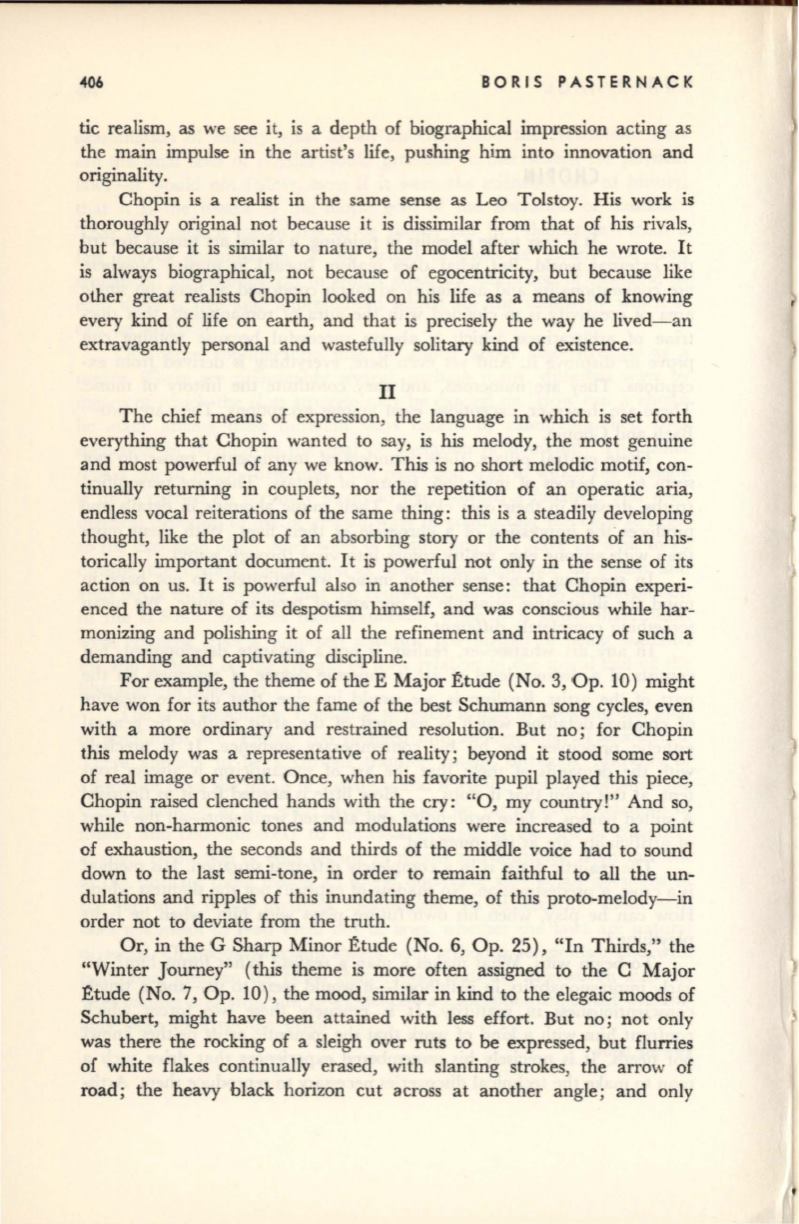
406
BORIS PASTERNACK
tic realism, as we see it, is a depth of biographical impression acting as
the main impulse in the artist's life, pushing him into innovation and
originality.
Chopin is a realist in the same sense as Leo Tolstoy. His work is
thoroughly original not because it is dissimilar from that of his rivals,
but because it is similar to nature, the model after which he wrote.
It
is always biographical, not because of egocentricity, but because like
other great realists Chopin looked on his life as a means of knowing
every kind of life on earth, and that is precisely the way he lived-an
extravagantly personal and wastefully solitary kind of existence.
II
The chief means of expression, the language in which is set forth
everything that Chopin wanted to say, is his melody, the most genuine
and most powerful of any we know. This is no short melodic motif, con–
tinually returning in couplets, nor the repetition of an operatic aria,
endless vocal reiterations of the same thing: this is a steadily developing
thought, like the plot of an absorbing story or the contents of an his–
torically important document. It is powerful not only in the sense of its
action on us. It is powerful also in another sense: that Chopin experi–
enced the nature of its despotism himself, and was conscious while har–
monizing and polishing it of all the refinement and intricacy of such a
demanding and captivating discipline.
For example, the theme of the E Major Etude (No.3, Op. 10) might
have won for its author the fame of the best Schumann song cycles, even
with a more ordinary and restrained resolution. But no; for Chopin
this melody was a representative of reality; beyond it stood some sort
of real image or event. Once, when his favorite pupil played this piece,
Chopin raised clenched hands with the cry:
"0,
my country!" And so,
while non-harmonic tones and modulations were increased to a point
of exhaustion, the seconds and thirds of the middle voice had to sound
down to the last semi-tone, in order to remain faithful to all the un–
dulations and ripples of this inundating theme, of this proto-melody-in
order not to deviate from the truth.
Or, in the G Sharp Minor Etude (No.6, Op. 25), "In Thirds," the
"Winter Journey" (this theme is more often assigned to the C Major
Etude (No.7, Op. 10), the mood, similar in kind to the elegaic moods of
Schubert, might have been attained with less effort. But no; not only
was there the rocking of a sleigh over ruts to be expressed, but flurries
of white flakes continually erased, with slanting strokes, the arrow of
road; the heavy black horizon cut across at another angle; and only


